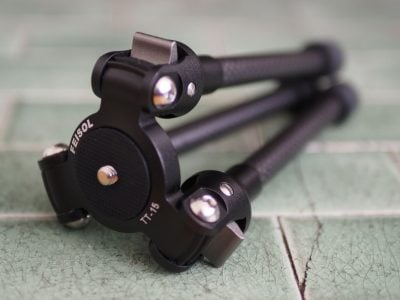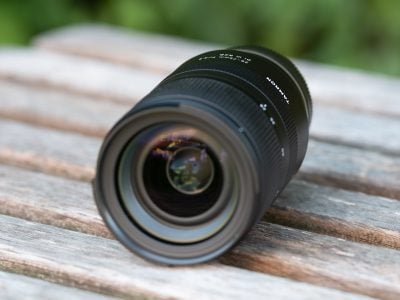Tamron 28-75mm f2.8 review
-
-
Written by Thomas
Quality
Testing: Longitudinal Chromatic Aberration and focus shift
Lenses with focal ratios of f2.8 or larger are often prone to longitudinal color aberrations (loCA, a.k.a. “axial color” or “bokeh CA”). These show up as magenta coloration in the foreground and greenish hues in the background and are not easily corrected in post-processing. The new Tamron is no exception: it shows some loCA at f2.8 and f4.0.
Tamron 28-75mm f2.8 Longitudinal Chromatic Aberration (loCA)

100% crops, from top to bottom: f2.8, f4.0, f5.6; left = foreground, right = background
The effect is gone at f5.6. The test also reveals a little focus shift when stopping down from f4.0 to f5.6.
Sharpness and contrast
Let’s have a look at the theoretical performance of the new Tamron 28-75mm f2.8 first and compare it to the performance of the Nikon Z 24-70mm f4S:
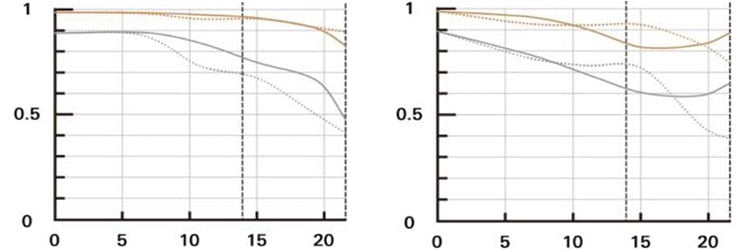
Above: MTF Tamron 28-75mm f2.8 at 28mm, f2.8 (left) and 75mm, f2.8 (right)
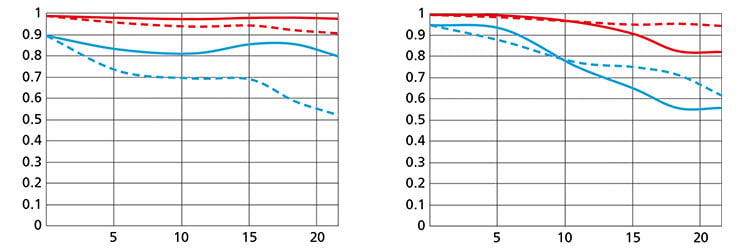
Above: MTF Nikon Z 24-70mm f4S at 24mm, f4.0 (left) and 70mm, f4.0 (right)
These MTF charts show the computed lens-performance of lenses wide open without influence of diffraction. Higher values are better (more contrast) and the closer the line-pairs are together the less astigmatism (= resolution depends on the orientation of the test-pattern) the lens has. The x-axis displays the distance from the optical axis (=center of the sensor) in mm. I’ll show you the real-life performance at 4 mm (center), 13 mm (APS-C-corner), and 20 mm (FF-corner) on a 42MP Sony A7R II body.
From the charts the new Tamron 28-75mm f2.8 should be pretty good although trailing the Nikon Z 24-70mm f4S especially at the short end. But this is not a fair apples-to-apples comparison as the Tamron is shown here at f2.8 vs. the Nikon at f4.0 which favors the Nikon.
Let’s see how this theoretical performance translates into real life results in the sharpness test based on Siemens-stars. Processing was done in Lightroom 8/CRAW 11 from RAW to Adobe Color profile with the built-in lens profile applied (with shading and CA compensation ON, distortion compensation OFF). Noise-reduction is set to 0, sharpening to 50/0.5/36/10, with no extra tone, color, or saturation adjustment. White-balance was adjusted to a neutral white and I did some exposure compensation to make the brightness of all crops match. So you will not see light fall-off in the corners. Removal of lateral color aberrations is ON, longitudinal CA are not corrected.
The following are all 100% crops!
First up is an overview of the wide-open performance at different focal lengths. You can jump to the detailed results at different apertures and comparisons with the Nikon Z 24-70mm f4S by clicking on the crops of the respective focal length.
Tamron 28-75mm f2.8; 100% crop from center, APS-C-corner, FF-corner

Above: 28mm, f2.8

Above: 35mm, f2.8

Above: 50mm, f2.8

Above: 75mm, f2.8
Tamron’s new lens delivers excellent sharpness in the center and very good sharpness at the APS-C corner throughout the zoom-range with just a little softening at 75mm. The FF-corner looks pretty soft in comparison with it’s weakest performance at 35mm. The lens exhibits very little field curvature at the long end but has some at the shorter focal lengths.
If you want to see all the details and comparisons with the Nikon Z 24-70mm f4S, read on. Or you can fast-forward to the performance at long distances.
The following 100% crops for each focal length show the new Tamron 28-75mm f2.8 from f2.8 down to f11 compared to the Nikon Z 24-70mm f4S (shot on a Z7 with application of the lens profile) at f4.0.
Performance at 28mm:
Tamron 28-75mm f2.8 at 28mm; 100% crop from center, APS-C-corner, FF-corner

Above: Tamron 28-75mm f2.8 at 28mm, f2.8

Above: Tamron 28-75mm f2.8 at 28mm, f4.0

Above: Nikon Z 24-70mm f4S on a Z7 at 28mm, f4.0

Above: Tamron 28-75mm f2.8 at 28mm, f5.6

Above: Tamron 28-75mm f2.8 at 28mm, f8.0

Above: Tamron 28-75mm f2.8 at 28mm, f11
At 28mm the new Tamron’s 28-75mm f2.8 is even sharper in the APS-C image circle than Nikon new Z 24-70mm f4S. Impressive. But in the FF-corner the Nikon wins. Stop the Tamron down to f8 to get good FF-corner performance.
Performance at 35mm:
Tamron 28-75mm f2.8 at 35mm; 100% crop from center, APS-C-corner, FF-corner

Above: Tamron 28-75mm f2.8 at 35mm, f2.8

Above: Tamron 28-75mm f2.8 at 35mm, f4.0

Above: Nikon Z 24-70mm f4S on a Z7 at 35mm, f4.0

Above: Tamron 28-75mm f2.8 at 35mm, f5.6

Above: Tamron 28-75mm f2.8 at 35mm, f8.0

Above: Tamron 28-75mm f2.8 at 35mm, f11
Same as at 28mm with the exception that Tamron’s FF-corner does not sharpen up as nicely when stopped down.
Performance at 50mm:
Tamron 28-75mm f2.8 at 50mm; 100% crop from center, APS-C-corner, FF-corner

Above: Tamron 28-75mm f2.8 at 50mm, f2.8

Above: Tamron 28-75mm f2.8 at 50mm, f4.0

Above: Nikon Z 24-70mm f4S on a Z7 at 49mm, f4.0

Above: Tamron 28-75mm f2.8 at 50mm, f5.6

Above: Tamron 28-75mm f2.8 at 50mm, f8.0

Above: Tamron 28-75mm f2.8 at 50mm, f11
Same story as at 35mm.
Performance at 75mm:
Tamron 28-75mm f2.8 at 35mm; 100% crop from center, APS-C-corner, FF-corner

Above: Tamron 28-75mm f2.8 at 75mm, f2.8

Above: Tamron 28-75mm f2.8 at 75mm, f4.0

Above: Nikon Z 24-70mm f4S on a Z7 at 70mm, f4.0

Above: Tamron 28-75mm f2.8 at 75mm, f5.6

Above: Tamron 28-75mm f2.8 at 75mm, f8.0

Above: Tamron 28-75mm f2.8 at 75mm, f11
Overall Tamron’s new 28-75mm f2.8 standard zoom convinces with very good to excellent performance in the APS-C circle. But outside (i.e. beyond 15mm image height) it softens visibly
Performance at long distances
The Siemens-star test-targets are shot at a distance of 45x focal length (i.e. at around 3.4m for 75mm focal length). But performance of lenses also depends on the shooting distance. Therefore I present another series of test-shots of a city around 1 km away. Processing was done in Lightroom 8/CRAW 11 from RAW to Adobe Color profile with the lens-profile automatically applied. Noise-reduction is set to 0, sharpening to 50/0.5/36/10, with no extra tone, color, or saturation adjustment. I used autofocus at the largest aperture and did not change focus for other apertures. All shots were made at ISO 100 and VR switched off.
First up is an overview of the wide-open performance at different focal lengths. You can jump to the detailed results at different apertures and comparisons with the Nikon Z 24-70mm f4S shot on a Z7 by clicking on the crops of the respective focal length. As usual I have selected the diagonal that provided the better corner results as almost any lens is a bit decentered.
Tamron 28-75mm f2.8; 100% crop from center, APS-C-corner, FF-corner

Above: 28mm, f2.8

Above: 35mm, f2.8

Above: 50mm, f2.8

Above: 75mm, f2.8
In this long-distance test the new Tamron 28-75mm f2.8 repeats its (very) good performance from the previous test. And although the FF-corner seems a bit soft it is still very usable even wide open.
If you want to see all the details and comparisons with the Nikon Z 24-70mm f4S on a Z7, read on. Or fast-forward to the next chapter on vignetting.
The main image shows the complete scene wide open to give you an impression of the angle of view and to judge vignetting. You can access the respective shots up to f11 via the links beneath the main image. Following the main image are 100% crops for each focal length from the new Tamron 28-75mm f2.8 down to f11 compared to the Nikon Z 24-70mm f4S on a Z7 at f4.0. Both lenses were shot on the same day within minutes of each other.
You can click on each image to access the large original. Please respect our copyright and only use those images for personal use.
Results at 28mm:
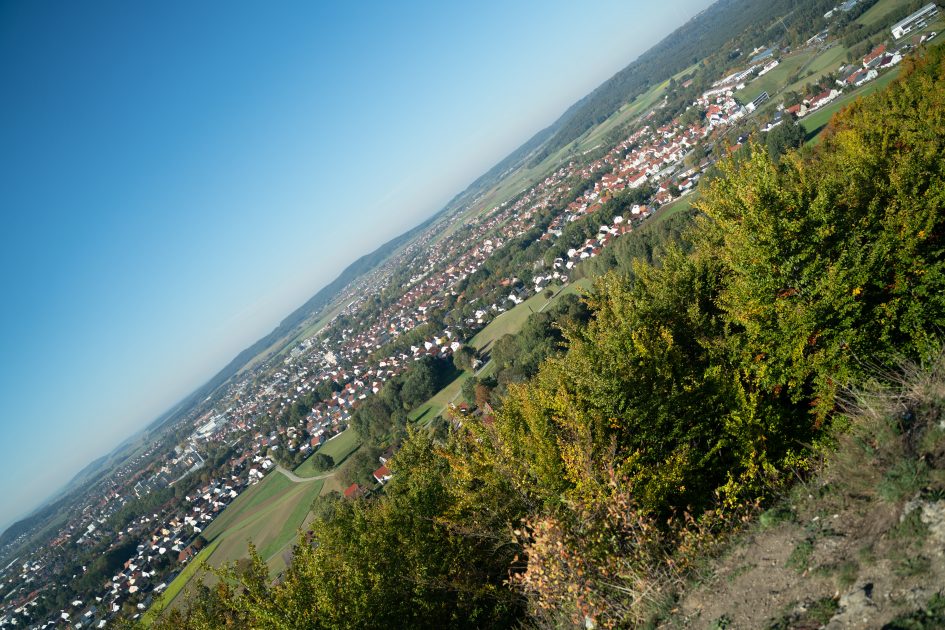
Above: Tamron 28-75mm f2.8 at 28mm, f2.8; click image to access original at Flickr; also available at f4.0, f5.6, f8.0, f11

Above: Tamron 28-75mm f2.8 at 28mm, f2.8; 100% crop from center, APS-C-corner, FF-corner

Above: Tamron 28-75mm f2.8 at 28mm, f4.0; 100% crop from center, APS-C-corner, FX-corner

Above: Nikon Z 24-70mm f4S on a Z7 at 28mm, f4.0; 100% crop from center, APS-C-corner, FF-corner; also available at f5.6, f8.0, f11

Above: Tamron 28-75mm f2.8 at 28mm, f5.6; 100% crop from center, APS-C-corner, FX-corner

Above: Tamron 28-75mm f2.8 at 28mm, f8.0; 100% crop from center, APS-C-corner, FX-corner

Above: Tamron 28-75mm f2.8 at 28mm, f11; 100% crop from center, APS-C-corner, FF-corner
Results at 35mm:
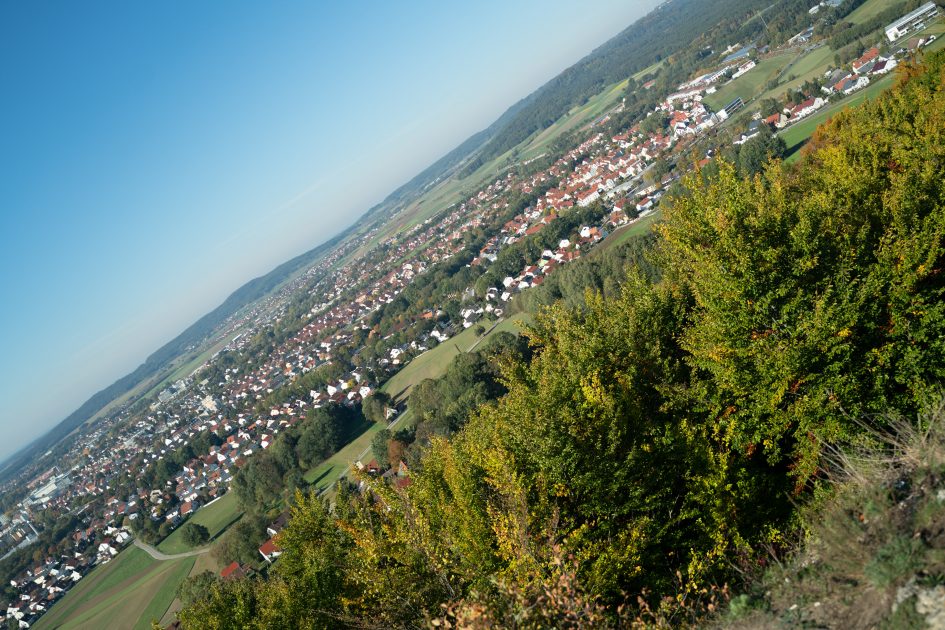
Above: Tamron 28-75mm f2.8 at 35mm, f2.8; click image to access original at Flickr; also available at f4.0, f5.6, f8.0, f11

Above: Tamron 28-75mm f2.8 at 35mm, f2.8; 100% crop from center, APS-C-corner, FF-corner

Above: Tamron 28-75mm f2.8 at 35mm, f4.0; 100% crop from center, APS-C-corner, FX-corner

Above: Nikon Z 24-70mm f4S on a Z7 at 35mm, f4.0; 100% crop from center, APS-C-corner, FF-corner; also available at f5.6, f8.0, f11

Above: Tamron 28-75mm f2.8 at 35mm, f5.6; 100% crop from center, APS-C-corner, FX-corner

Above: Tamron 28-75mm f2.8 at 35mm, f8.0; 100% crop from center, APS-C-corner, FF-corner

Above: Tamron 28-75mm f2.8 at 35mm, f11; 100% crop from center, APS-C-corner, FF-corner
Results at 50mm:
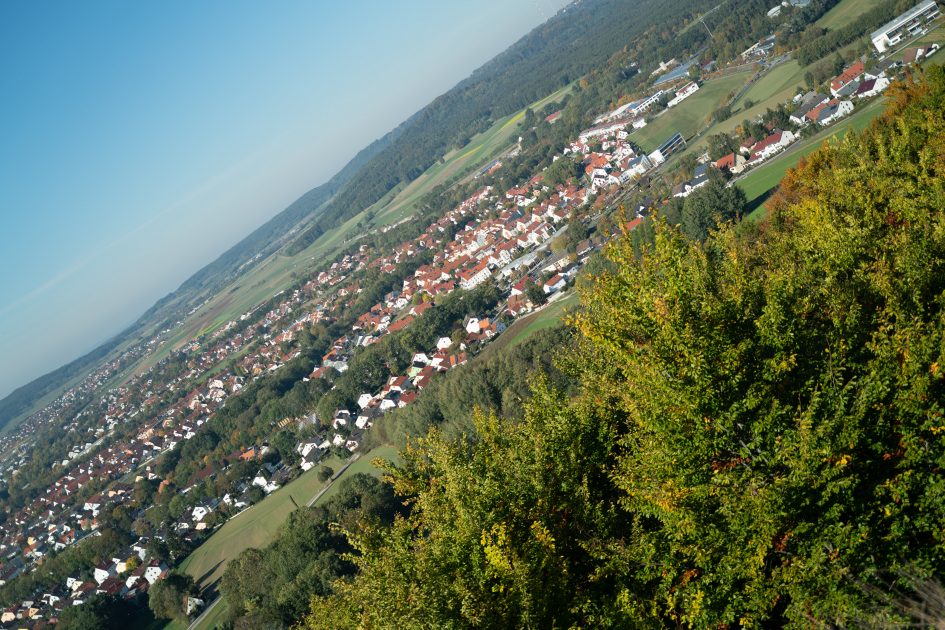
Above: Tamron 28-75mm f2.8 at 50mm, f2.8; click image to access original at Flickr; also available at f4.0, f5.6, f8.0, f11

Above: Tamron 28-75mm f2.8 at 50mm, f2.8; 100% crop from center, APS-C-corner, FF-corner

Above: Tamron 28-75mm f2.8 at 50mm, f4.0; 100% crop from center, APS-C-corner, FX-corner

Above: Nikon Z 24-70mm f4S on a Z7 at 50mm, f4.0; 100% crop from center, APS-C-corner, FF-corner; also available at f5.6, f8.0, f11

Above: Tamron 28-75mm f2.8 at 50mm, f5.6; 100% crop from center, APS-C-corner, FX-corner

Above: Tamron 28-75mm f2.8 at 50mm, f8.0; 100% crop from center, APS-C-corner, FF-corner

Above: Tamron 28-75mm f2.8 at 50mm, f11; 100% crop from center, APS-C-corner, FF-corner
Results at 75mm:
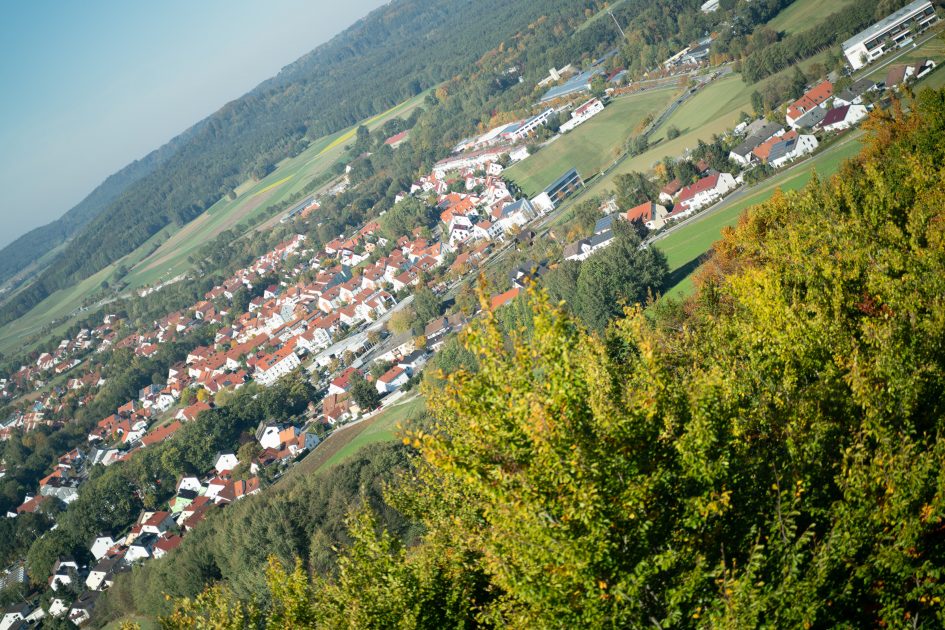
Above: Tamron 28-75mm f2.8 at 75mm, f2.8; click image to access original at Flickr; also available at f4.0, f5.6, f8.0, f11

Above: Tamron 28-75mm f2.8 at 75mm, f2.8; 100% crop from center, APS-C-corner, FF-corner

Above: Tamron 28-75mm f2.8 at 75mm, f4.0; 100% crop from center, APS-C-corner, FX-corner

Above: Nikon Z 24-70mm f4S on a Z7 at 70mm, f4.0; 100% crop from center, APS-C-corner, FF-corner; available at f5.6, f8.0, f11

Above: Tamron 28-75mm f2.8 at 75mm, f5.6; 100% crop from center, APS-C-corner, FX-corner

Above: Tamron 28-75mm f2.8 at 75mm, f8.0; 100% crop from center, APS-C-corner, FF-corner

Above: Tamron 28-75mm f2.8 at 75mm, f11; 100% crop from center, APS-C-corner, FF-corner
As seen before the new Tamron delivers very good results. Its slight weaknesses at the long end and outside the APS-C image-circle can be alleviated by stopping down to f4.0 or f5.6.
Vignetting and distortions
Vignetting and distortions are lens aberrations that can be easily corrected by software. Lightroom and Photoshop have offered lens profiles for some time which could be applied as an option. With most mirrorless systems though, Adobe applies lens profiles automatically whether you want them or not. But on Sony Alpha mirrorless cameras you can switch lens compensation off separately for vignetting, colour aberrations, and distortions. I had compensation for vignetting and CA ON and for distortions OFF.
To make it easier to see light fall-off (after compensation) in the corners of a full-frame sensor I’ve arranged a series of three shots each with the new Tamron at different apertures. All images were developed to the same brightness in the center and the lens profile applied. The first line shows vignetting at 28mm focal length, the second at 75mm:
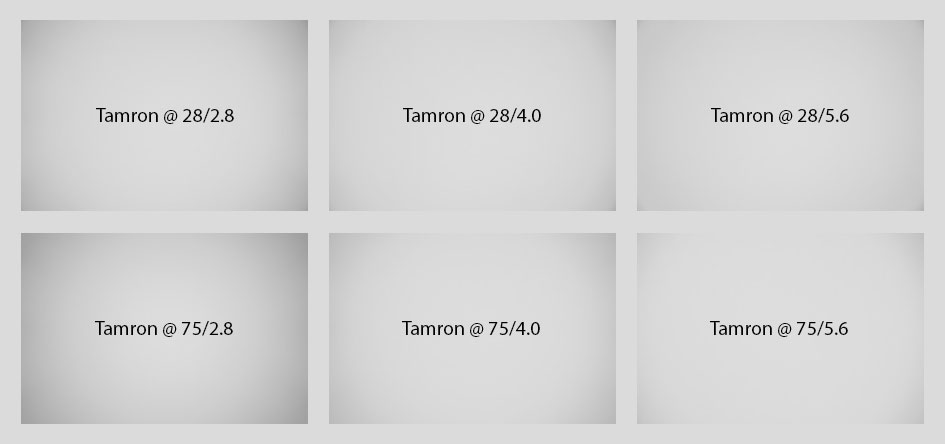
Above: Tamron 28-75mm f2.8 at 28mm and 75mm focal length
The sample images above show that even with the lens profile applied vignetting is not completely eliminated.
Distortions are of the barrel type at 28mm with a slight mustachio effect, well corrected at 35mm and turn to pin-cushion from 50mm onwards. See the examples at the end of the samples page.
Rendering of point-light sources at night-shots
Night-shots pose a different challenge for lenses as the contrast is even higher than under bright sun and point-light sources can reveal some weaknesses such as coma, haloing and colour-aberrations that do not show up as prominently in other test-shots. The 100% crops below the main image show the effect of coma in the FF-corner of the new Tamron and the Nikon Z 24-70mm f4S at various apertures:

Above: Tamron 28-75mm f2.8 at 28mm, f2.8; also available at f4.0, f5.6, f8.0

Above: Tamron 28-75mm f2.8 at 28mm; 100% crops from the FF-corner at f2.8 (left), f4.0 (middle), f5.6 (right)

Above: Nikon Z 24-70mm f4S on a Z7 at 24mm; 100% crops from the FF-corner at f4.0 (left), f5.6 (middle), f8.0 (right)
On the short end the new Tamron 28-75mm f2.8 has pretty little coma at f2.8 and f4.0 but still a bit more than the Nikon Z 24-70mm f4S at f4.0.
Coma at 75mm:
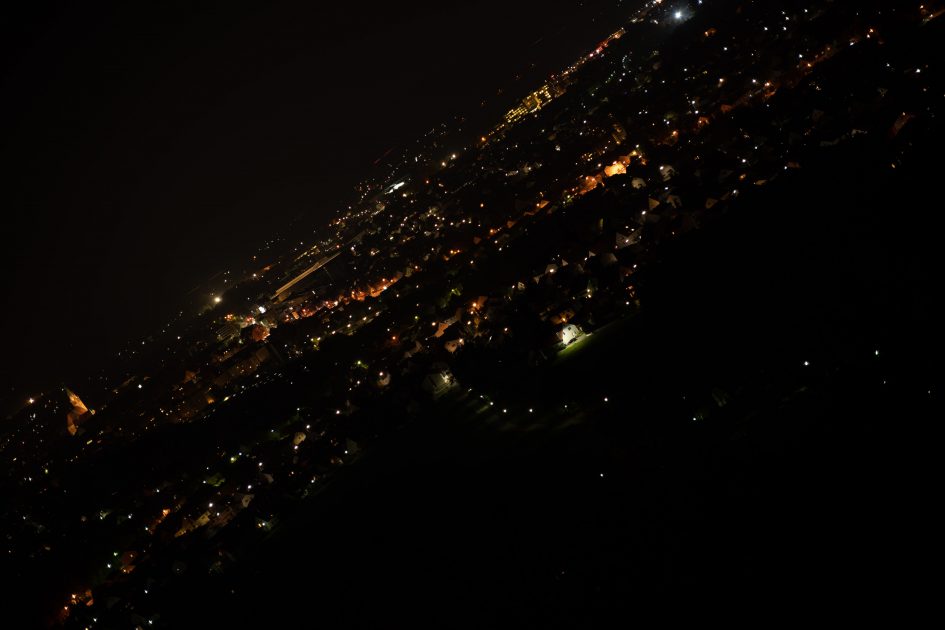
Above: Tamron 28-75mm f2.8 at 75mm, f2.8; also available at f4.0, f5.6, f8.0

Above: Tamron 28-75mm f2.8 at 75mm; 100% crops from the FF-corner at f2.8 (left), f4.0 (middle), f5.6 (right)

Above: Nikon Z 24-70mm f4S on a Z7 at 70mm; 100% crops from the FF-corner at f4.0 (left), f5.6 (middle), f8.0 (right)
On the long end the new Tamron 28-75mm f2.8 pulls ahead with a little less coma than the Nikon Z 24-70mm f4S.
Rendering of out-of-focus point-light sources
This test is for the rendering of point-light sources in an out-of-focus background. The circle of confusion that is produced by this test is pretty indicative of Bokeh performance (in the background) and light fall-off. Ideally the out-of-focus image of the point-light is evenly lit and perfectly circular, with no “onion-rings”, and without coloration. Large aperture lenses normally produce an effect known as “cat’s eye” the further away from the optical axis the point-light is projected. This is due to optical vignetting in the lens barrel when light enters the lens from an angle.
All images were shot at the longest focal length and largest aperture. The new Tamron is first followed by the Nikon Z 24-70mm f4S.
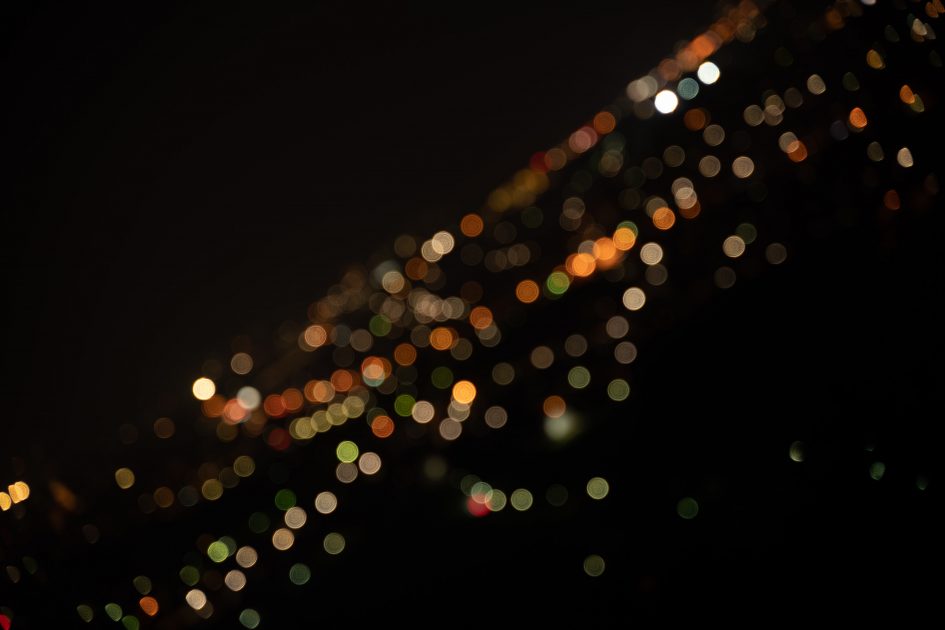
Above: Tamron 28-75mm f2.8 at 75mm, f2.8; also available at f4.0, f5.6, f8.0

Above: Tamron 28-75mm f2.8 at 75mm, f2.8; 44% crops from center, DX-corner, FX-corner

Above: Nikon Z 24-70mm f4S on a Z7 at 70mm, f4.0; 44% crops from center, DX-corner, FX-corner; also available at f5.6, f8.0
Shot at f2.8 the new Tamron produces the bigger Bokeh balls than the Nikon Z 24-70mm f4S can. Which was to be expected as a result from its larger focal ratio. But the new 28-75mm f2.8 shows a pretty bright outline while the Z Nikkor is much more evenly lit. The new Tamron compresses the Bokeh balls already in the DX-corner at f2.8 but at f4.0 the lens cat’s eye effect is similar to the Z Nikkor.
Now let’s see how this analysis of out-of-focus point-light sources translates into Bokeh-performance shooting a book-shelf.
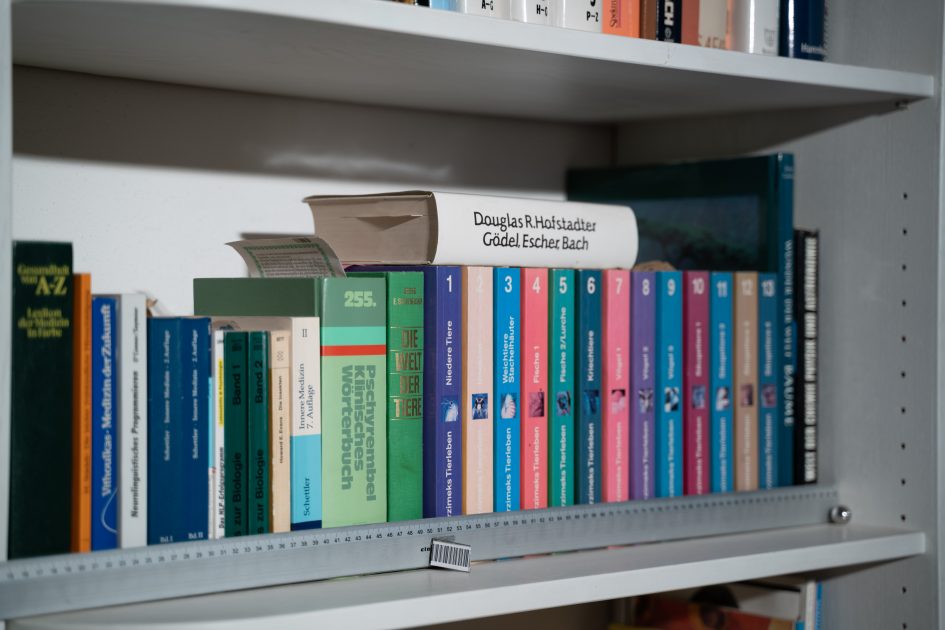
Above: Tamron 28-75mm f2.8 at 75mm, f2.8; click image to access original at Flickr; also available at f4.0, f5.6, f8.0

Above: Tamron 28-75mm f2.8 at 75mm, f2.8; 44% crops from foreground, middle-ground, background

Above: Nikon Z 24-70mm f4S on a Z7 at 70mm, f4.0; 44% crops from foreground, middle-ground, background; also available at f5.6, f8.0
Comparing the lenses at their longest focal length and largest aperture these test shots show the advantage of the Tamron 28-75mm f2.8 when shot at f2.8. Foreground, background, and the transition zone (middle-ground) are softer than from the new Nikon Z 24-70mm f4S at f4.0 although with a more nervous Bokeh in the background due to outlining.
Close-up performance
As the new Tamron can achieve quite a good magnification at closer distances it is interesting to see how the lens performs in close-up shooting. The following images were shot with the longest focal length at 1:4 magnification where the area if sharp focus is just 96 x 144mm. The crops shown below are from 2mm, 8mm, and 17mm off the center of the sensor respectively:

Above: Tamron 28-75mm f2.8 at 75mm, f5.6; 100% crops

Above: Nikon Z 24-70mm f4S at 70mm, f5.6; 100% crops
The new Tamron produces very usable results in the center while becoming increasingly soft beyond 10mm image height. The new Z Nikkor in comparison performs a bit better in the outer areas of the full-frame sensor.
Flare, ghosting, and sun-stars
Catching a strong light-source shining directly into the lens is always a risky business: it could produce strange colourful ghost-images or reduce contrast considerably through flare and glare. The appearance of flare and ghosting depends on factors like the aperture and the angle of the light hitting the lens. So to judge the proclivity of the new Tamron 28-75mm f2.8 for these artefacts I went through a series of well calculated shots against a strong light source to provoke glare and ghosting.
The new Tamron 28-75mm f2.8 is pretty clear of flare and glare artefacts except when the light-source is at or near the center. Outside these artefacts the new lens renders a deep black, so there’s little veiling glare. See a comparison of both lenses at 75/70mm f11 where the effects are most obvious:
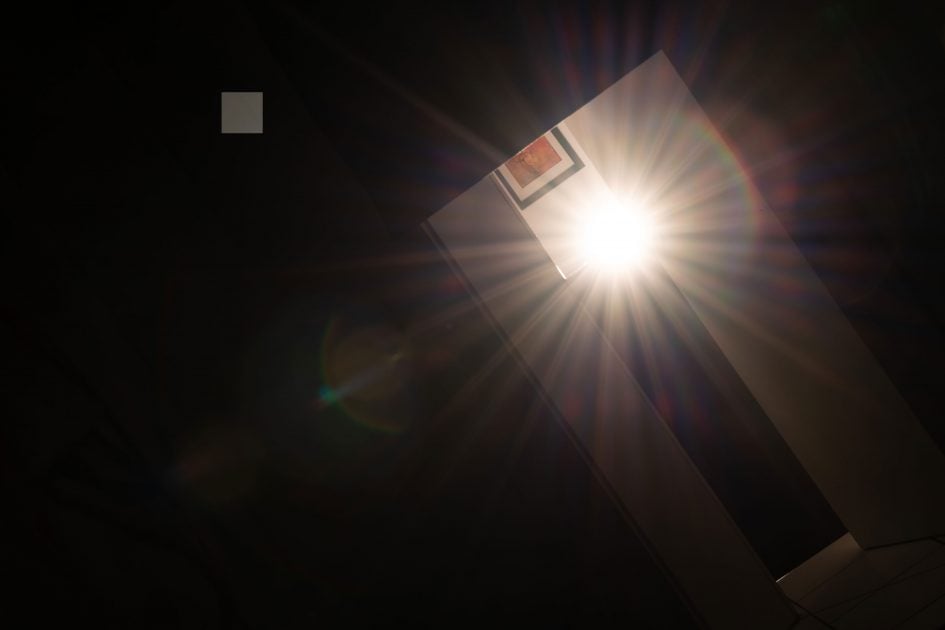
Above: Flare and ghosting. Strong light hitting the Tamron 28-75mm f2.8 at 75mm, f11
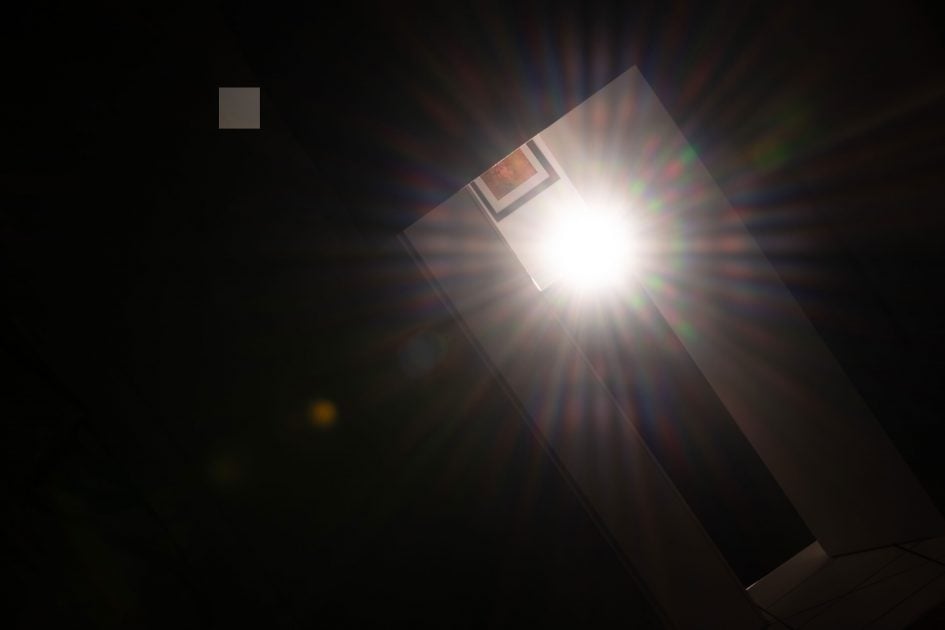
Above: Flare and ghosting. Strong light hitting the Nikon Z 24-70mm f4S at 70mm, f11
The little bright square inset in the upper left of both images shows the respective area with an exposure compensation of +3 EV to make it easier to see which levels of black the lens renders at that point. It shows that the new Tamron 28-75mm f2.8 produces similar black levels to the new Z Nikkor.
The following images show the sun-stars of the Tamron 28-75mm f2.8 at 28mm and 75mm focal length at f11 and the artefacts when the light-source is in the center of the image – a position best to be avoided. At the wide end of the lens sun-stars are pretty well defined while they lose some of their definition at 75mm focal length.
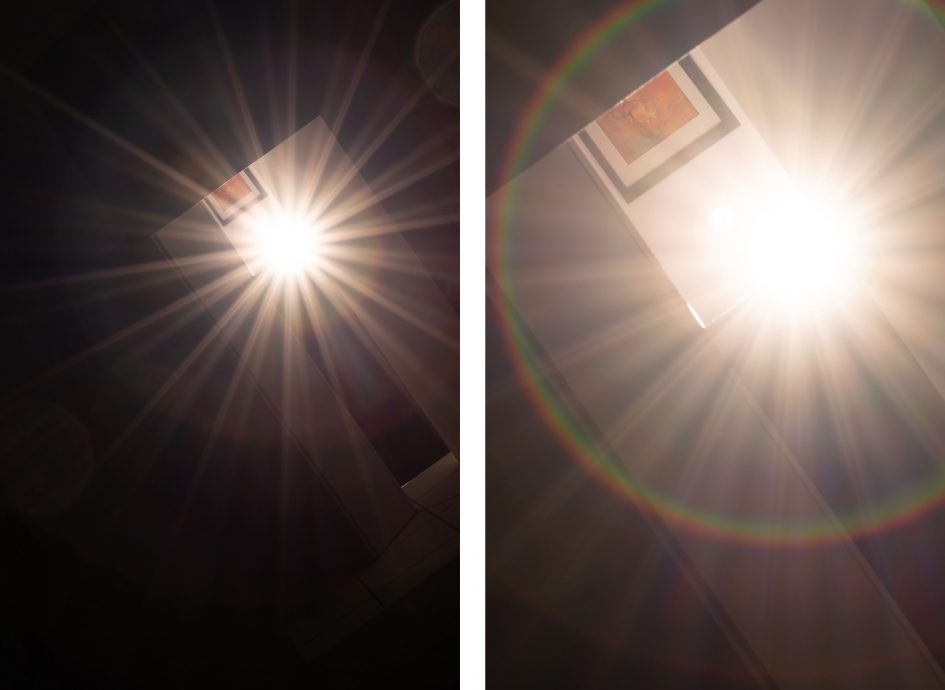
Above: Tamron 28-75mm f2.8 at 28mm, f11 (left) and 75mm, f11 (right), cropped
Next check out my sample images!
Check prices on the Tamron 28-75mm f2.8 at Amazon, B&H, Adorama, or Wex. Alternatively get yourself a copy of my In Camera book or treat me to a coffee! Thanks!